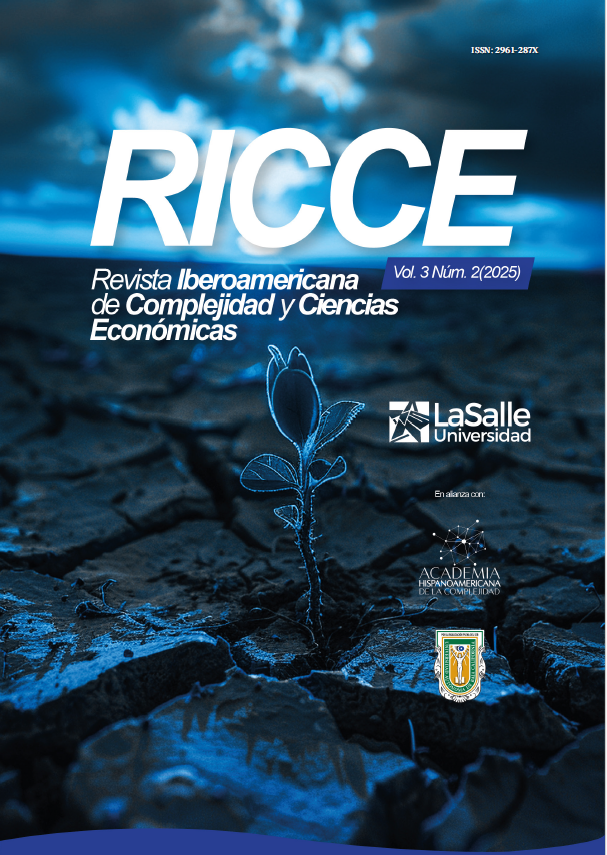CURRICULAR ENTROPY AND COMPLEX NETWORKS FOR THE DEVELOPMENT OF SCHOOL ENVIRONMENTAL PROJECTS (PRAE)
Abstract
This article presents a curricular entropy indicator and a complex network approach to the climate crisis to strengthen the development and contextualization of School Environmental Projects (SEPs). This research considers socio-environmental dimensions of the climate crisis, highlighting the need for a holistic understanding. In this sense, taking into account environmental factors related to this phenomenon, such as greenhouse gases (GHGs), fires, and deforestation, the implementation of the notion of curricular entropy is proposed as a teaching strategy that nonlinearly interconnects the curriculum, actively engages students, and strengthens environmental education. Furthermore, a methodology for assessing the entropy of a curricular design for a pedagogical intervention is presented, providing a metric for the diversity and complexity of curricular adaptation. In conclusion, the implementation of curricular entropy indicators and the implementation of complex climate change networks in School Environmental Projects (SEPs) promotes the understanding of flexibility, nonlinearity in the curriculum, and interdisciplinary processes associated with small-world networks.
Downloads
References
Barabasi, A.-L. (2003). Linked: How Everything Is Connected to Everything Else and What It Means for Business, Science, and Everyday Life.
Bastian, M. (2009). (PDF) Gephi: An Open Source Software for Exploring and Manipu¬lating Networks. https://www.researchga¬te.net/publication/221297890_Gephi_An_ Open_Source_Software_for_Exploring_and_ Manipulating_Networks
Bateson, G. (with Internet Archive). (1979). Mind and nature: A necessary unity. New York : Dutton. http://archive.org/details/ mindnaturenecess0000bate
Bryk, A. S., & Schneider, B. (2002). Trust in Schools: A Core Resource for Improvement. Russell Sage Foundation. https://www.js¬tor.org/stable/10.7758/9781610440967
Candia, C., Pulgar, J., & Pinheiro, F. (2022). Interconnectedness in Education Systems.
Castro Sáez, B. (2001). LA ORGANIZACION EDUCATIVA: UNA APROXIMACION DESDE LA COMPLEJIDAD. Estudios pedagógicos (Val¬divia), 27, 97-110. https://doi.org/10.4067/ S0718-07052001000100007
Chevalard, Y. (2013). Chevalard, Y. La Tras¬posición Didáctica. http://archive.org/de-tails/chevalard-y.-la-trasposicion-didactica
Dawson, J. L. (2021). A Guide to Feedback Theory. Cambridge University Press. https:// doi.org/10.1017/9781139018289
Edgar Morin. (2006). Morin, Edgar. El Mé¬todo. Vol. 1. La Naturaleza De La Naturaleza [ocr] [2006]. http://archive.org/details/mo¬rin-edgar.-el-metodo.-vol.-1.-la-naturale¬za-de-la-naturaleza-ocr-2006
Fritzsch, H. (2018). Quarks. En H. Fritzsch (Ed.), Murray Gell-Mann and the Physics of Quarks (pp. 49-51). Springer International Publishing. https://doi.org/10.1007/978-3- 319-92195-2_5
Fullan M. (2007). El nuevo significado del cambio educativo -. https://michaelfullan. ca/books/new-meaning-educational-chan¬ge/
Gell-Mann, M. (1994). Complex Adaptive Sys¬tems (G. Cowan, D. Pines, & D. Meltzer, Eds.; 19; Número 19, pp. 17-45). Addison-Wesley. https://resolver.caltech.edu/CaltechAU-THORS:20150924-144445402
Hattie, J. (2009). Visible Learning: A Syn¬thesis of Over 800 Meta-Analyses Rela¬ting to Achievement. En Visible Learning: A Synthesis of Over 800 Meta-Analyses Relating to Achievement. https://doi. org/10.4324/9780203887332
Herrington J., Oliver Ron. (2000). An ins¬tructional design framework for authentic learning environments | Educational techno¬logy research and development. https://link. springer.com/article/10.1007/BF02319856
Holland, J. H. (2005). El Orden Oculto. Fondo de Cultura Economica USA.
Holling, C. S. (1973). Resilience and Stability of Ecological Systems. Annual Review of Eco¬logy, Evolution, and Systematics, 4(Volume 4, 1973), 1-23. https://doi.org/10.1146/annu¬
rev.es.04.110173.000245
Korthagen Fred A.J. (2009). Situated lear¬ning theory and the pedagogy of teacher education: Towards an integrative view of teacher behavior and teacher learning. CE¬TAR, VU University, Amsterdam, The Nether¬lands. chrome-extension://efaidnbmnnnibp-cajpcglclefindmkaj/https://korthagen.nl/en/ wp-content/uploads/2018/07/Situated-lear¬ning-theory-and-the-pedagogy-of-tea¬cher-education.pdf
Krajcik j. y Blumenfeld P. (2005). Project-Ba¬sed Learning (Chapter 19)—The Cambridge Handbook of the Learning Sciences. https:// www.cambridge.org/core/books/abs/cam-bridge-handbook-of-the-learning-sciences/ projectbased-learning/355AA45D92D7FCD-5D312FD1C343FDBB2
Leff, E. (2000). Saber ambiental: Sustentabili¬dad, racionalidad, complejidad, poder / E. Leff.
Leinster, T. (2020). Entropy and diversity The axiomatic approach.
Maldonado, C. E. (2016). Pensar como la na¬turaleza. Una idea radical. Uni-pluriversidad, 16(2), 41-51.
Maturana, H. R. (with Internet Archive). (1980). Autopoiesis and cognition: The reali¬zation of the living. Dordrecht, Holland ; Bos¬ton : D. Reidel Pub. Co. http://archive.org/de-tails/autopoiesiscogni0042matu
Minambiente. (2019). Guía PRAE. https:// www.minambiente.gov.co/documento-enti-dad/guia-prae/
Newman, M. E. J. (2003). The structure and function of complex networks. SIAM Review, 45(2), 167-256. https://doi.org/10.1137/ S003614450342480
Penrose Roger , Jorgensen Palle. (2008). The Road to Reality: A Complete Guide to the Laws of the Universe. https://www.resear¬chgate.net/publication/226597688_The_ Road_to_Reality_A_Complete_Guide_to_ the_Laws_of_the_Universe
Perkins, D. (2009). Making learning who¬le: How seven principles of teaching can transform education: Perkins, David N : Free Download, Borrow, and Streaming: Internet Archive. https://archive.org/details/makin¬glearningwh0000perk
Perkins, D. (2023). Perkins, D. Educar Para Un Mundo Cambiante ¿ Qué Necesitan Apren¬der Realmente Los Alumnos Para El Futuro. http://archive.org/details/perkins-d.-edu-car-para-un-mundo-cambiante-que-nece¬sitan-aprender-realmente-los-a
Prigogine, I. (1997). Prigogine, Ilya. Las Le¬yes Del Caos [ocr] [1997]. http://archive.org/ details/prigogine-ilya.-las-leyes-del-caos-ocr-1997
Prigogine, I., & Rysselberghe, P. V. (1963). Introduction to Thermodynamics of Irre¬versible Processes. Journal of The Electro¬chemical Society, 110(4), 97C. https://doi. org/10.1149/1.2425756
Shannon, C. E. (1948). A Mathematical Theory of Communication.
Stiggins, R. (2005). From Formative Assess¬ment to Assessment for Learning: A Path to Success in Standards-Based Schools. Phi Delta Kappan, 87(4), 324-328. https://doi. org/10.1177/003172170508700414
Copyright (c) 2025 Iberoamerican Journal of Complexity and Economics Sciences

This work is licensed under a Creative Commons Attribution-NonCommercial-NoDerivatives 4.0 International License.
The authors transfer exclusively the right to publish their article to the Iberoamerican Journal of Complexity and Economics Sciences, which may formally edit or modify the approved text to comply with its own editorial regulations and with universal grammatical standards, before its publication; Likewise, our journal may translate the approved manuscripts into as many languages as it deems necessary and disseminate them in various countries, always giving public recognition to the author or authors of the research.









